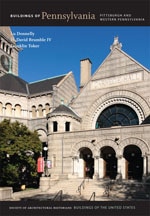When the town's Presbyterians decided they needed a private school, they turned to Philadelphia's well-published architect Samuel Sloan, whose book Model Architect (published from 1851 onward) was about to be reissued for the fourth time. He designed this large, three-story, Colonial Revival building with a central pedimented block flanked by mansard-roofed wings to the east and west. The building has pronounced extruded mortar between the irregularly laid golden-toned stone that had been quarried on the site. The school's philosophy was to “shun mere display and affectation, and to give practical knowledge.” It was coeducational for only one year, after which the boys were banished for misbehavior. Highland Hall became a well-known girls' school in 1906, with John King McLanahan as the major stockholder. In 1911, his son, architect Martin Hawley McLanahan, in partnership with William Price, oversaw extensive renovations and designed an addition with practice rooms, an infirmary, and sleeping porches, as well as a separate gymnasium and boiler house-laundry. The McLanahan family remained involved with the school through 1940, as long as their daughters attended it. After several post–World War II uses, including as a Franciscan preparatory school and a courthouse annex, the building is awaiting its next function.
You are here
Highland Hall
If SAH Archipedia has been useful to you, please consider supporting it.
SAH Archipedia tells the story of the United States through its buildings, landscapes, and cities. This freely available resource empowers the public with authoritative knowledge that deepens their understanding and appreciation of the built environment. But the Society of Architectural Historians, which created SAH Archipedia with University of Virginia Press, needs your support to maintain the high-caliber research, writing, photography, cartography, editing, design, and programming that make SAH Archipedia a trusted online resource available to all who value the history of place, heritage tourism, and learning.















